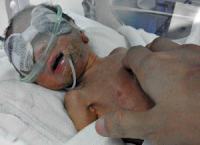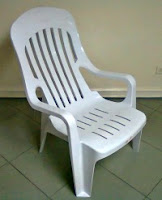 |
| [Image by ceejayoz via Wikimedia Commons] |
It’s easy to feel helpless when you’re a preemie’s parent. You see that the doctors and nurses are already doing everything they can for your child. What more could you possibly contribute?
But there are some things only we parents – not the doctors and nurses – can do to improve our preemie’s chances of survival. Here are some steps you can take to help your preemie survive:
1. Know the enemy: nosocomial infection
Once your baby receives oxygen support and intravenous fluids, the rest of it begins to look like just a waiting game: Wait for the lungs to develop. Wait for the baby to reach normal birth weight. Then get discharged and go home.
But one thing can and will change that waiting game into a tense medical battle. The doctors call it nosocomial infection; in non-medicalese, it is hospital-acquired infection, one of life’s cruelest ironies.
Hospital germs are like the Olympic medalists of the germ world. These are the germs that have survived disinfectants, ultraviolet treatments, and ordinary antibiotic drugs that have eradicated lesser germs.
If our babies get infected with germs from the hospital, the battle will be fought with the most powerful (and expensive) antibiotics our doctors have in their arsenal.
Sometimes, these antibiotics are still not enough to save the baby’s life.
Therefore, our number 1 goal is to protect our babies from hospital-acquired infection. The next steps talk about how to do that.
2. Provide your own fresh unpasteurized breastmilk
At the NICU, from what I observed, the milk bank receives supplied or donated breastmilk, puts the milk together in an anonymous communal stock, and then the nurses feed the babies from this anonymous supply.
Of course, this communal stock needs to be pasteurized.
Pasteurization is good because it kills germs that may come from the donor mother.
However, pasteurization also injures some of the immunological components of breastmilk. As a result, your child gets less protective benefit from pasteurized milk than from fresh unpasteurized milk.1
To give my baby maximum protection from nosocomial infection, I asked the doctors and nurses not to give my baby milk from the pasteurized stock.
Instead, I expressed fresh milk for him every feeding time.
During the times when I had to go home, I made sure I left enough milk right inside my baby’s bassinet and endorsed the milk to the nurse.
In case I had to be away for more than 8 hours, I also left a bag of milk in the freezer, clearly labeled with my baby’s name, and endorsed that to the nurse as well.
After my baby had received the milk he needed, the rest of the milk was sent to the communal supply.
3. Protect your breastmilk from hospital germs
It is likely that the hospital has a breast pump you can use to express milk for your baby.
Avoid using it if you can.
Remember, this is a pump that many other mothers use. You do not know the health conditions of the mothers who used the pump before you.
Also, does the hospital sanitize the pump each time an individual uses it? I don’t know – do you?
To ensure that my milk did not get contaminated, I hand expressed directly into a sterile disposable milk bag.
Hand expression is ideal because hands are far easier to sanitize than any pump in the world. If your hands are unsoiled, a good rub with alcohol solution is all you need.2
The Marmet hand expression video tutorials can help you get started with hand expressing your milk. Eventually you can modify the technique into what works best for you.
Now if you really prefer to use a breast pump, I would recommend you bring your own. A manual pump is a good option because it operates almost soundlessly and never needs to be plugged or recharged. (Some hospitals might not allow you to plug in your pump.)
If you must use the hospital’s pump, bring your own connectors and milk collection bottles, at the very least. Avoid using the connectors that everyone else uses.
Bring milk bags as well for storing your milk, and have a permanent marker on hand to label the bag with your baby’s name and the time that the milk was expressed.
If you have problems expressing enough breastmilk for your baby, do not hesitate to seek the help of a lactation counselor.
One that I have worked with and highly recommend is Abby Yabot, a Philippine General Hospital (PGH)–certified lactation counselor. She regularly holds breastfeeding talks at The Parenting Emporium. You can reach her by calling/texting 0917-5614366.
4. Do kangaroo mother care.
Kangaroo mother care (KMC) was taught to me by my baby’s attending physician, Dr. Amanda Du. She and the nurses of the PGH were huge advocates of it, and it is easy to understand why.
KMC is a lifesaver for preemies.
This practice of carrying your baby skin-to-skin for extended periods of time (4 to 23.5 hours per day) has been proven to
- reduce the risk of nosocomial infection,
- lower the chances of hospital readmission,
- facilitate exclusive breastfeeding,
- soothe baby’s pain from hospital procedures, and
- help keep the baby warm.3
Another crucial KMC benefit is that it keeps the baby warm.
When babies are cold, their bodies are forced to expend more calories to keep them warm or they will die from hypothermia.
But you don’t want your baby to waste calories on generating body heat. You want your baby to use calories to gain weight and escape from the scary NICU as soon as possible.
KMC uses the mother’s body heat to warm the baby, so baby can preserve his own calories and dedicate all of them to gaining those precious pounds.
Because the PGH recognizes how important and beneficial KMC is, they allow a mother or father doing KMC to stay with their child way beyond visitation hours.
By doing KMC, I was able to stay with my baby for 32 hours at a time, so I could also closely monitor his feeding and his IV drip, soothe him when they took blood samples or did transfusions, and just talk to him, letting him know he was not alone and that he was loved.
5. Get hold of a supplemental nursing system.
A supplemental nursing system (SNS) is basically a milk reservoir with one end of a long, soft, thin tube attached to its opening. The other end of the tube is placed inside your baby’s mouth while the baby is breastfeeding or finger feeding.
Finger feeding is a technique used to correct poor latch. We let baby suck on our finger while we use that same finger to guide baby’s tongue into its proper latch position.
When baby sucks on our nipple or finger with the SNS tube in position, the resulting vacuum pulls milk from the receptacle and into the tube, which then delivers the milk to your baby’s mouth.
The SNS is used to train preemies to breastfeed. This training is important because, even after babies have attained their required weight, doctors will still not discharge them from the NICU if they have not acquired a “good suck.”
The problem is, preemies aren’t very good at direct breastfeeding. My preemie, for instance, would just suckle a little and then fall asleep. He also had the bad habit of keeping his tongue up, so he was unable to achieve a good latch.
That’s why we had to do finger feeding before we could feed directly from the breast.
The SNS lets our babies get milk while sucking on our finger, so they learn to associate sucking with feeding.
At the breast, the SNS allows baby to get more milk. This prevents baby from falling asleep after just a few sucks.
Click here to read more SNS tips from another mom.
The Medela SNS is available at The Parenting Emporium. Ask about it by contacting 0917-5614366.
6. Apply virgin coconut oil on your preemie's skin.
In 2015, a study showed that coconut oil applied on the skin of very low birth weight infants significantly reduced the degree of water loss compared to those who did not have coconut oil applied to their skin.
While those who were given coconut oil only lost an average of 3.48 g/m2 of water per hour, those who did not receive the oil lost 10.15 g/m2 of water per hour.4
Why does water loss through the skin matter?
Among babies born with normal weight, water lost through the skin is not an issue.
But among preemies, the evaporation of water through the skin causes the babies’ bodies to lose heat.5
We have already discussed why it is so important for preemies to preserve their body heat: they need to preserve their calories to attain optimal weight gain. We don’t want them to waste calories in producing body heat.
Aside from calorie preservation, the application of coconut oil on baby’s skin has another benefit, which is directly related to our avoidance of nosocomial infection.
In the same 2015 study, the researchers found that the babies who received coconut oil had only 20% bacterial growth on their skin, while the other babies had 60%.4
A separate study6 found that the rate of hospital-acquired infection among preterm infants who had coconut oil applied to their skin twice a day was only 18% compared to those who did not receive topical coconut oil (39.5 vs. 219.1, respectively, per 1000 patient days).
DISCLAIMER: I am not a doctor, and I am definitely not your preemies' doctor. Before you do anything with your preemie, make sure you get your neonatologist’s go-signal. A practice that has been beneficial for one baby may, due to differing circumstances, be harmful to another.
I wish the best for you and your preemie. If you need somebody to talk with who will understand what you’re going through, feel free to email me at badlaon@gmail.com.
REFERENCES
- Wight NE. Donor human milk for preterm infants. J Perinatol. 2001;21(4):249–254. Available from: http://www.ncbi.nlm.nih.gov/pubmed/11533843.
- Santacatalina Mas R, Peix Sagues MT, Miranda Salmeron J, et al. Surgical hand washing: handscrubbing or handrubbing [in Spanish]. Rev Enferm. 2016;39:8-16. Available from: http://www.ncbi.nlm.nih.gov/pubmed/27101645.
- Boundy EO, Dastjerdi R, Spiegelman D, et al. Kangaroo mother care and neonatal outcomes: a meta-analysis. Pediatrics. 2016;137:e20152238. Available from: http://onlinelibrary.wiley.com/doi/10.1111/jpc.13218/abstract.
- Nangia S, Paul VK, Deorari AK, et al. Topical oil application and trans-epidermal water loss in preterm very low birth weight infants—a randomized trial. J Trop Pediatr. 2015;61(6):414–420. Available from: http://www.ncbi.nlm.nih.gov/pubmed/26338490.
- Rutter N, Hull D. Water loss from the skin of term and preterm babies. Arch Dis Child. 1979;54(11):858–868. Available from: http://www.ncbi.nlm.nih.gov/pmc/articles/PMC1545609/.
- Salam RA, Darmstadt GL, Bhutta ZA. Effect of emollient therapy on clinical outcomes in preterm neonates in Pakistan: a randomised controlled trial. Arch Dis Child Fetal Neonatal Ed. 2015;100(3);F210–F215. Available from: http://www.ncbi.nlm.nih.gov/pubmed/25637007.














